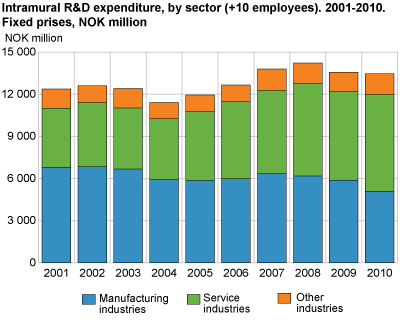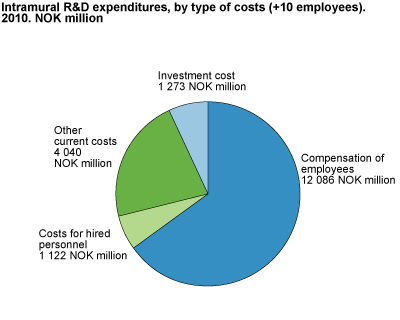Content
Published:
This is an archived release.
Stagnation in R&D activity
Preliminary figures show that Norwegian business enterprises spent about NOK 18.5 billion on research and development (R&D) in 2010. This is an increase of 1.7 per cent in nominal terms compared with 2009, but a decrease of 0.8 per cent in fixed prices. The number of R&D man-years performed decreased by 1.5 per cent.
There was a marked growth in R&D activity in business enterprises until 2008, after which it stagnated. Measured in fixed prices, R&D expenditures were reduced slightly in both 2009 and 2010. The business enterprise sector as a whole expects stability in 2011. The estimates by enterprises in the second quarter of 2011 indicate a weak increase in R&D expenditure of about 3 per cent (nominal) and an unchanged number of R&D man-years performed.
In addition, R&D worth NOK 1.6 billion was carried out in enterprises with 5-9 employees. The total intramural R&D expenditure for the business enterprise sector in 2010 thus amounts to about NOK 20.1 billion.
A weak decline in R&D man-years
A total of 15 444 R&D man-years were performed in enterprises with more than 10 employees in 2010; a decline of 1.5 per cent compared with 2009. Sixty-nine per cent of these man-years were performed by personnel with higher education. In enterprises with 5-9 employees, 1 380 R&D man-years were carried out.
Increased investments
Of the R&D expenditure, the investments in buildings and machinery increased the most. The investments amounted to almost NOK 1.3 billion in 2010; an increase of NOK 251 million or 24.6 per cent compared with 2009. There are often large variations in the investments from year to year. Compensation of employees is the largest expenditure component, with nearly NOK 12.1 billion in 2010. This is only a slight increase of 1 per cent from 2009. Other current costs (including costs for hired personnel) decreased by 1.1 per cent.
Manufacturing and service industries
Manufacturing enterprises spent NOK 7 billion on R&D in 2010; 11 per cent lower than in 2009. Enterprises in the service industries contributed with nearly NOK 9.5 billion in R&D expenditure in 2010, which is 11.4 per cent higher than the year before. This is partly due to the reclassification of enterprises between manufacturing and services. Such reclassifications are due to changes in enterprise activities and the fact that the division between manufacturing and services may be blurred. Other industries (including extraction of petroleum and gas) had a growth of 11.8 per cent, and contributed in excess of NOK 2 billion in 2010.
Reduced share of GDP
The R&D expenditure in the business enterprise sector measured as a share of gross domestic product (GDP) decreased from 0.78 in 2009 to 0.74 per cent in 2010. The R&D expenditure’s share of gross product on mainland Norway was reduced from 0.99 to 0.96 per cent.
About the dataThe R&D statistics are based on information collected from the enterprises. All enterprises with 50 employees or more are included. In addition, a sample of enterprises with 5-49 employees is drawn and total figures for this group are calculated based on this sample. As a result, there is greater uncertainty surrounding the results for the small enterprises. It must be emphasised that the figures in this article are preliminary and may be changed. In the preliminary figures, complete entries from some large R&D enterprises are missing, and the entries for these enterprises are therefore estimated. |
Tables:
- Table 1 R & D in Business Enterprise Sector. Intramural R & D expenditure, R & D-personnel and R & D man-years by Industry and size class. 2008-2010. NOK million and number of
- Table 2 Intramural R & D expenditures in Business Enterprise sector by type of costs, Industry and size class (+10 employees). 2010. NOK million
Find more figures
Find detailed figures for Research and development in the business enterprise sector
Contact
-
Kristine Langhoff
E-mail: kristine.langhoff@ssb.no
tel.: (+47) 40 90 24 39
-
Claudia Berrios
E-mail: claudia.berrios@ssb.no
tel.: (+47) 40 90 24 51
-
Harald Fondevik
E-mail: harald.fondevik@ssb.no
tel.: (+47) 40 90 24 47


